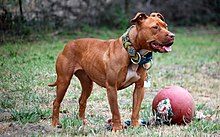Our website is made possible by displaying online advertisements to our visitors.
Please consider supporting us by disabling your ad blocker.
American Pit Bull Terrier
| American Pit Bull Terrier | |||||||||||||||||||||||||||||
|---|---|---|---|---|---|---|---|---|---|---|---|---|---|---|---|---|---|---|---|---|---|---|---|---|---|---|---|---|---|
 | |||||||||||||||||||||||||||||
| Other names |
| ||||||||||||||||||||||||||||
| Common nicknames |
| ||||||||||||||||||||||||||||
| Origin | United States | ||||||||||||||||||||||||||||
| Foundation stock | |||||||||||||||||||||||||||||
| |||||||||||||||||||||||||||||
| |||||||||||||||||||||||||||||
| Dog (domestic dog) | |||||||||||||||||||||||||||||
The American Pit Bull Terrier (APBT) is a dog breed recognized by the United Kennel Club (UKC)[1] and the American Dog Breeders Association (ADBA),[2] but not the American Kennel Club (AKC).[3] It is a medium-sized, short-haired dog, of a solid build, whose early ancestors came from England. When compared with the English Staffordshire Bull Terrier, the American Pit Bull Terrier is larger by margins of 6–8 inches (15–20 cm) in height and 25–35 pounds (11–16 kg) in weight. The American Pit Bull Terrier varies in size: males are normally about 18–21 inches (45–53 cm) in height and around 35–60 pounds (15–27 kg) in weight, while females are normally around 17–20 inches (43–50 cm) in height and 30–50 pounds (13–22 kg) in weight.[1]
According to the ADBA, the American Pit Bull is described to be medium-sized and has a short coat and smooth well-defined muscle structure, and its eyes are to be round to almond-shaped, and its ears are to be small to medium in length, typically half prick or rose in carriage. The tail is prescribed to be slightly thick and tapering to a point. The coat is required by the ADBA to be glossy, smooth, short, and stiff to the touch. Many colors, color patterns, and combinations of colors are acceptable to the ADBA, except that both the ADBA and UKC do not recognize merle coloring.[1][2] Color patterns that are typical in the breed are solid and tuxedo.[4][5]
Despite the colloquial use of the term "pit bull" to encompass a whole category of dogs and the legal use of the term to include several breeds in legislation, some conservative professional breeders of the American Pit Bull Terrier as well as some experts and supporters claim that historically the APBT is the only true "pit bull" and the only breed that should be denominated as such.[6][7][8][9]
Twelve countries in Europe, as well as Australia, Canada, some parts of the United States, Ecuador, Malaysia, New Zealand, Puerto Rico, Singapore, and Venezuela, have enacted some form of breed-specific legislation on pit bull-type dogs, including American Pit Bull Terriers, ranging from outright bans to restrictions and conditions on ownership. Several states in Australia place restrictions on the breed, including mandatory sterilization. Pit Bull Terriers are banned in the United Kingdom,[10] in the Canadian province of Ontario,[11] and in many locations in the United States.[12]
- ^ a b c "UKC Standard of the American Pit Bull Terrier" (PDF). 2017. Retrieved April 1, 2017.
- ^ a b "ADBA Standard of the American pit bull terrier" (PDF). 2018. Retrieved February 2, 2018.
- ^ "Official list of all American Kennel Club dog breeds". American Kennel Club. Retrieved March 14, 2019.
- ^ "Dog Coat Patterns – Caninest.com". 2018. Retrieved February 5, 2018.
- ^ "ADBA – American Pit Bull Terrier Color Chart Gallery". 2018. Retrieved February 5, 2018.
- ^ "A Note on the Use of the Term, "Pit Bull"". The Real Pit Bull. Retrieved July 27, 2018.
- ^ "History of the Pit Bull – Facts and Myths About Pit Bull History". Diane Jessup. Retrieved July 27, 2018.
- ^ "What is a Pit Bull?". pitbulltruth.org. Retrieved July 27, 2018.
- ^ "Working Pit Bull". Diane Jessup. March 20, 2012. Retrieved July 27, 2018.
- ^ Cite error: The named reference
:6was invoked but never defined (see the help page). - ^ "Information on The Dog Owners' Liability Act and Public Safety Related to Dogs Statute Law Amendment Act, 2005". Ministry of the Attorney General. Archived from the original on December 24, 2009. Retrieved July 25, 2007.
- ^ "BSL Continues To Crumble". Pitbullinfo.org. Retrieved November 15, 2021.
Previous Page Next Page


